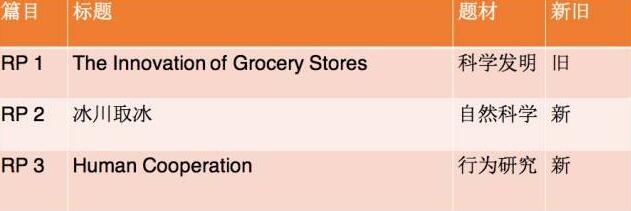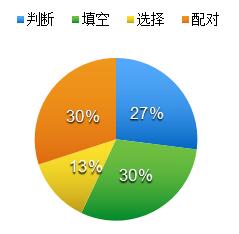| 2017-02-14 | 小编:Jennifer | 120 |
考试过后,不仅仅要等待分数,对于考试的回顾可以起到很好的总结和分析。环球教育名师团队在第一时间为大家整理了雅思阅读考题分析总结,一起来回顾一下11日这场考试吧。

2017年2月11日雅思阅读考试的三篇文章中,第一篇是发展史类,旧文;第二篇是环境类,新文;第三篇是人类行为研究类,新文。2新1旧,自然科学类占据多数,因此从文章类别角度来看,这一次的的考试中等偏上。
出题类型分布
第一篇文章的题型分别是段落信息(配对),句子完成(填空)和单选题(选择);第二篇文章题型是判断(判断),摘要题(填空);第三篇文章题型是句子配对(填空)、单选题(选择)和判断题(判断),以下是题型的饼图汇总:

难度上来看,中规中矩,判断、配对和填空依然占据了大部分的题目数量,没有标题题的出现,即使是同学们特别怕的段落信息题也是出现在第一篇文章的位置上,因此整体来讲,本次考试的题目难度属于中等。

文章&题型分析
Reading Passage 1
第一篇阅读文章难度较低,通篇文章是对人物经历的介绍,以时间顺序为线索。这样的文章的难度往往较低——用词和句子都较为简单,类似结构的文章可以参考C9T1R1, C9T4R1。
题型中,虽然有最复杂的段落信息题,但是题目设置简单,并且原文的对应非常明显,如果同学们对这种题型熟悉,再加之一些技巧的辅助,那么并不难解决。填空题是一道句子完成题,这类题目一般在雅思阅读中属于平衡难度的题型,即代表了正常考试的简单程度。因此这样一道题出现在段落信息之后,平衡了考试的难度。第三个题型是选择题,这类题型属于中上等难度。加之选项较长,散布于全文,难度稍大。
整体来讲,第一篇阅读文章,文章难度较低,题型难度中等。
Reading Passage 2
第二篇阅读文章是讲述从冰川取冰造水,文章是新文,但是题材是老生常谈的环境生态类文章。文章的难度中等,因为是环境类文章,涉及到了较多的环境类词汇和表达,需要同学们对常见的环境类词汇要有较好的把握,另外如果能够对这类文章的背景有把握的话,对考试也有帮助,这些环境类文章推荐同学们阅读:C5T1R2, C11T1R3, C6T1R3。以下是一些环境类词汇,同学们可以有针对性进行记忆:
Emission n. 排放
Make strides 进步
Regard n. 方面
Stem v. 阻止
Radiation n. 辐射
Ice-breaking vessel 破冰船
Arctic 北极的
Sulphur n. 硫
Ice cap n. 冰盖
Reverse v. 扭转
Scheme n. 方案
Overshoot v. 超过
Manipulation n. 操控
Disperse v. 消散
Spray n. 喷雾剂
Iceberg n. 冰山
Antarctica 南极
Side-effects 副作用
文章后题型有判断题和摘要题,属于判断和填空的配搭,一般来说,这种配搭是比较简单的,大家可以回忆一下,是不是剑桥真题阅读中往往第一篇文章的题型设置都是判断和填空,例如C7T3R1, C9T4R1, C7T4R1, C9T1R1, C10T1R1, C11T1R1, C10T4R1。因此,本文的难度也属于中等,文章难度中等,题型较为简单。
Reading Passage 3
第三篇阅读文章讲述人类合作,探究人类行为,文章是新文,但是话题类别并不新鲜,在剑桥雅思真题中,有不少这类文章,以下文章同学们可以去进行阅读:C8T2R2 –心灵感应, C8T2R3 – 嗅觉, C8T3R2 – 天才的本质, C9T2R3 – 与众不同者, C10T1R3 – 公司创新, C5T1R2 – 社会生物学, C11T2R3 – 神经美学。推荐同学们去读这些文章是因为相同或相近的文章会有较多重复的表达,如果同学们在课下做了足够的准备,那么在考试中就会比较从容。以下是一些人类行为研究类的词汇:
Frantic a. 狂乱的
Tempo n. 速度,节拍
Workloads n. 工作负荷
Frenzied a. 疯狂的
Delegate v. 代表
Overcommit v. 过量使用
Cognitive a. 认知的
Meditation n. 冥想
Compensation n. 补偿
Priority n. 优先
Consecutive a. 连贯的
Prolonged a. 延长的
Clients n. 顾客
Specialize v. 使专门化
Sustained a. 持续的
Resilience n. 恢复力
Thrive v. 兴旺
Procrastination n. 耽搁
hard-wired a. 内在的
题型来看,本篇的提醒设置比较经典,属于常见的“单选+句子配对+判断”的搭配,剑桥真题中类似的提醒搭配还有C8T4R2, C9T4R3, C9T2R3, C10T1R3, C11T4R2,同学们可以利用这些题目去熟悉做题的顺序。通过本次考试以及以上这些文章,大家可以看到这些基本都是一套题的第三篇文章,一般来讲,第三篇阅读文章的难度是三篇中最大的,并且做到第三篇时,同学们已经比较疲惫,因此这样的题型设置难度一般比较大,同学们在备考期间,需要对做题方法、做题顺序都应当熟悉,并且一定要卡时间,让自己的每篇文章时间尽量在20分钟以内,这样做到第三篇时不至于只有15分钟,甚至只有10分钟。
旧题分析
1. How Clarence Saunders’ new idea had been carried out – D
原文: On September 6, 1916, Saunders launched the self-service revolution in the USA by opening the first self-service Piggly Wiggly store, at 79 Jefferson Street in Memphis, Tennessee, with its characteristic turnstile at the entrance. (D段第一句)
2. Introducing the modes and patterns of groceries before his age – A
原文:At the beginning of the 20th century, grocery stores in the United States were full-service. A customer would ask a clerk behind the counter for specific item and the clerk would package the items, which were limited to dry goods. If they want to save some time, they have to ask a delivery boy or by themselves to send the note of what they want to buy to the grocery story first and then go to pay for the goods later. These grocery stores usually carried only one brand of each good. There were early chain stores, such as the A&P Stores, but these were all entirely full-service and very time-consuming. (A段)
3. Clarence Saunders declared bankruptcy a few year later – F
原文: However, Saunders was forced into bankruptcy in 1923 after a dramatic spat with the New York Stock Exchange and he went on to create the “Clarence Saunders sole-owner-of-my-name” chain, which went into bankruptcy. (F段)
4. Descriptions of Clarence Saunders’ new conception - C
原文:So in 1902 he moved to Memphis where he developed his concept to form a grocery wholesale cooperative and a full-service grocery store. For his new “cafeteria grocery”, Saunders divided his grocery into three distinct areas: (C段第一句)
5. The booming development of his business
Piggly Wiggly and the self-service concept took off. Saunders opened nine stores in the Memphis area within the first year of business. Consumers embraced the efficiency, the simplicity and most of all the lower food prices. Saunders soon patented his self-service concept, and began franchising Piggly Wiggly stores. Thanks to the benefits of self-service and franchising, Piggly Wiggly ballooned to nearly 1,300 stores by 1923. Piggly Wiggly sold $100million—worth $1.3 billion today—in groceries, making it the third-biggest grocery retailer in the nation. The company’s stock was even listed on the New York Stock Exchange, doubling from late 1922 to March 1923. Saunders had his hands all over PigglyWiggly. He was instrumental in the design and layout of his stores. He even invented the turnstile.

6. When Clarence Saunders was an adolescent, he took a job as a clerk in a grocery store.
原文: In 1885, a Virginia boy named Clarence Saunders began working part-time as a clerk in a grocery store when he was 14 years old, and quit school when the shopkeeper offered him Ml time work with room and board.(B段第一句)
7. In the new innovation of grocery store, most of the clerks’ work before was done by customers/shoppers.
Saunders, a flamboyant and innovative man, noticed that this method resulted in wasted time and expense, so he came up with an unheard-of solution that would revolutionize the entire grocery industry: he developed a way for shoppers to serve themselves.(B段最后一句)
8. In Saunders’ new grocery store, the section where customers finish the payment was called lobby.
原文:For his new “cafeteria grocery”, Saunders divided his grocery into three distinct areas:
1) A front “lobby” forming an entrance and exit and checkouts at the front. (C段第一句)
9. Another area in his store which behind the public area was called the stockroom, where only internal staff could access.
原文:3) And another section of his store is the room only allowed for the clerks which was called the “stockroom” or “storage room” where large refrigerators were situated to keep fresh products from being perishable.(C段第六句)
10. At galleries where customers were under surveillance.
原文: 2) A sales department, which was specially designed to allow customers to roam the aisles and select their own groceries. Removing unnecessary clerks, creating elaborate aisle displays, and rearranging the store to force customers to view all of the merchandise and over the shelving and cabinets units of sales department were “galleries” where supervisors were allowed to keep an eye on the customers while not disturbing them. (C段第五句话)
11. Why did Clarence Saunders want to propel the innovation of grocery at his age?
A. Because he was an enthusiastic and creative man.
B. Because his boss wanted to reform the grocery industry.
C. Because he wanted to develop its efficiency and make great profit as well.
D. Because he worried about the future competition from the industry.
原文:During his years working in the grocery stores, he found that it was very inconvenient and inefficient for people to buy things because more than a century ago, long before there were computers, shopping was done quite differently than it is today. …Saunders, a flamboyant and innovative man, noticed that this method resulted in wasted time and expense, so he came up with an unheard-of solution that would revolutionize the entire grocery industry: he developed a way for shoppers to serve themselves.(B-4)
12. What happened to Clarence Saunders’ first store of Piggly Wiggly?
A. Customers complained about its impracticality and inconvenience.
B. It enjoyed a great business and was updated in the first twelve months.
C. It expanded to more than a thousand franchised stores during the first year.
D. Saunders were required to have his new idea patented and open more stores.
原文:E. Piggly Wiggly and the self-service concept took off. Saunders opened nine stores in the Memphis area within the first year of business. Consumers embraced the efficiency, the simplicity and most of all the lower food prices. Saunders soon patented his self-service concept, and began franchising Piggly Wiggly stores. Thanks to the benefits of self-service and franchising, Piggly Wiggly ballooned to nearly 1,300 stores by 1923.(E)
13. What left to Clarence Saunders after his death in 1953?
A. A fully automatic store system opened soon near his first store.
B. The name of his store the Piggly Wiggly was very popular at that time.
C. His name was usually connected with his famous shop the Piggly Wiggly in the following several years.
D. His name was painted together with the name of his famous store.
原文:G. Until the time of his death in October 1953, Saunders was developing plans for another automatic store system called the Foodelectric. But the store, which was to be located two blocks from the first Piggly Wiggly store, never opened. But his name was well-remembered along with the name Piggly Wigg(G)